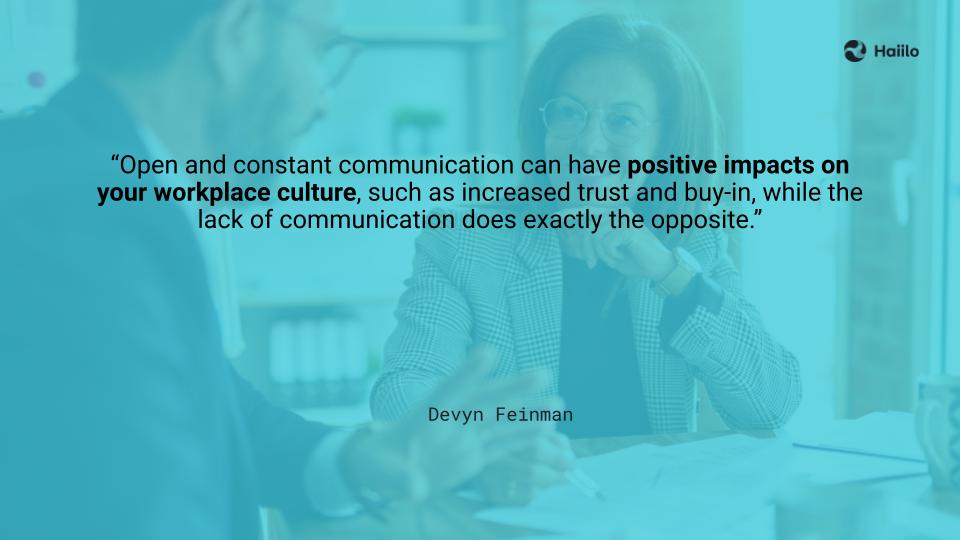You have, no doubt, seen (or perhaps been) a leader sharing information because it NEEDED to be shared. Perhaps they/you spent long hours boiling down the key points to make sure they made sense and then felt the frustration when they seemed to fall flat. When I first started in my role leading a communications team, I often told team members that if our audience doesn’t understand our message, we have failed, but I have since realized the key is not whether they understood what we were trying to say, but whether they connected with it.
💡Check out Measuring Success: Unveiling the Power of Metrics in Your Communication Strategy
Haiilo can help you connect with and empower your employees.
Recognize What You’re Working With
One of the inherent failures of general information sharing is the assumption that your employees are [genuinely] interested in what you have to say. A sweeping employee engagement survey done in 2022 by Gallup revealed around 70% of employees are disengaged, sighting reasons including:
- Unclear expectations
- Disconnection from company purpose/mission
- Lack of development opportunities
- Not feeling cared about at work
So, with that context established, let’s return to the challenge of connecting your messaging to your audience. If you take the assumption that the majority of your audience is disengaged, you can also have a relatively founded supposition that your employees are also experiencing the related causes of disengagement: feeling not listened to, not respected, not valued, and not fulfilled at work. You can then assume that telling them about how this new change will greatly help the company/ department reach the objectives this year will probably not get the impact you are looking for. Why? Because your disengaged workforce has decided that you and they are not on the same page…which boils down to: if you don’t care about me, why should I care about you?
📚Keep Reading: Top 5 Benefits of Connected Workplaces and How to Create One
Hate That Awkward Silence
Workplaces with poor communication practices have one thing in common: a misplaced notion that our need for information at work differs from our needs outside of it. On the contrary, it is important to remember that humans love sharing information: yes, for informative purposes, but also for the emotional connection it creates. Relatedly, open and constant communication can positively impact your workplace culture, such as increased trust and buy-in, while the lack of communication does the opposite. However, our goal is not to communicate for the sake of communicating. This only results in what our industry calls “noise” and overwhelms our employees with more useless information, further increasing feelings of misalignment between the company’s raison d’être and what our employees feel is their purpose at work (think about poorly placed advertisements on your social media channel and how disconnected it feels!) A well-made communications strategy always includes a messaging creation stage, and if this is done correctly, your outputs will successfully connect and resonate with your audience. If not, when your company management returns a month later upset that no one seems to have “gotten it” and are blaming the communications team, their observations will be completely valid- you have failed.
🔌Recharge your culture: 12 Guaranteed Ways to Improve Employee Satisfaction

Get to Know Me First
So, now that we have established that your audience may be captive but is probably not listening, it is time to look at how you are going to heal/bridge the gap. Without going too far into the culture work that needs to be addressed (and will be as a result of the approach below), there are ways of approaching your message crafting to improve the chance that your words resonate.
Think of the last time you heard a speaker and you thought to yourself, “exactly right!” or “that’s me!” what was the after-effect? You listened raptly because you felt they were really talking to YOU. Our goal is to replicate that feeling in our employees when they listen to the quarterly presentation or read our news. Ultimately, our goal is to have messages that resonate and have a personal impact. This can be accomplished through various methods, but one of my favorites is to transform the company message through a “what’s in it for me” exercise. Before starting, use any feedback you have collected and seek advice from people who can shed insight into your workforce perspective so that you can understand what is currently on their minds and where their interests lie. That being said, while collecting information is a start, nothing is more powerful than engaging your employees in focus groups directly. Take an open and transparent approach to ask for their advice and input on the subject choice to see what they want to know, what their questions are, and how they absorb the information. Then, take the information you have collected, craft messages that resonate with your audience, and watch the magic happen!
🔎Keep Reading: Employee Feedback Done Right: 9 Best Practices
This article originally appeared on LinkedIn and is reprinted with the permission of the author.
About the author
Devyn Feinman is a communications and change management professional with more than a decade of experience focused on cross-cultural communications and change management. She has a passion for facilitating discussions and encouraging new perspectives to find solutions, and loves finding the best approach to maximizing the value of any communication effort. Her significant experience in the African mining context has provided her a unique training ground and ample experience in creating adaptable and integrated techniques and approaches to bridging the communications gap too commonly found in large organizations.










